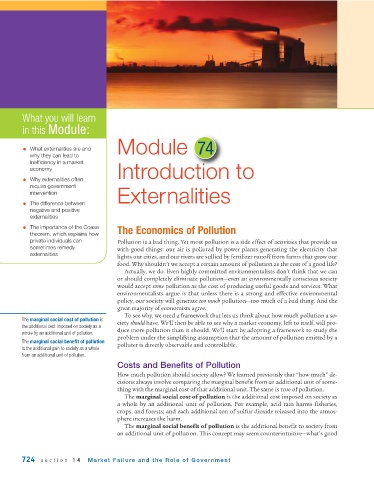Page 766 - Krugmans Economics for AP Text Book_Neat
P. 766
What you will learn
in this Module:
• What externalities are and Module 74
why they can lead to
inefficiency in a market
economy Introduction to
• Why externalities often
require government
intervention Externalities
• The difference between
negative and positive
externalities
• The importance of the Coase The Economics of Pollution
theorem, which explains how
private individuals can Pollution is a bad thing. Yet most pollution is a side effect of activities that provide us
sometimes remedy with good things: our air is polluted by power plants generating the electricity that
externalities
lights our cities, and our rivers are sullied by fertilizer runoff from farms that grow our
food. Why shouldn’t we accept a certain amount of pollution as the cost of a good life?
Actually, we do. Even highly committed environmentalists don’t think that we can
or should completely eliminate pollution—even an environmentally conscious society
would accept some pollution as the cost of producing useful goods and services. What
environmentalists argue is that unless there is a strong and effective environmental
policy, our society will generate too much pollution—too much of a bad thing. And the
great majority of economists agree.
To see why, we need a framework that lets us think about how much pollution a so-
The marginal social cost of pollution is
ciety should have. We’ll then be able to see why a market economy, left to itself, will pro-
the additional cost imposed on society as a
duce more pollution than it should. We’ll start by adopting a framework to study the
whole by an additional unit of pollution.
problem under the simplifying assumption that the amount of pollution emitted by a
The marginal social benefit of pollution
polluter is directly observable and controllable.
is the additional gain to society as a whole
from an additional unit of pollution.
Costs and Benefits of Pollution
How much pollution should society allow? We learned previously that “how much” de-
cisions always involve comparing the marginal benefit from an additional unit of some-
thing with the marginal cost of that additional unit. The same is true of pollution.
The marginal social cost of pollution is the additional cost imposed on society as
a whole by an additional unit of pollution. For example, acid rain harms fisheries,
crops, and forests; and each additional ton of sulfur dioxide released into the atmos-
phere increases the harm.
The marginal social benefit of pollution is the additional benefit to society from
an additional unit of pollution. This concept may seem counterintuitive—what’s good
724 section 14 Market Failure and the Role of Gover nment

